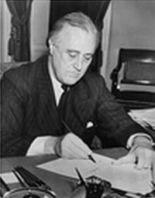This Week in History:
March 20 - 26, 1933
FDR
Launches Public Works
March 2011
 Franklin D. Roosevelt |
March 18, 1933 began the second phase of FDR's "Hundred Days" program, the one devoted explicitly to creating jobs. On that day, President Franklin D. Roosevelt met with his closest advisers and called on them to formulate major legislative measures on the job crisis, which had left tens of millions of Americans unemployed. Then, on March 21, the President sent a message to Congress, outlining his objectives.
What the President understood, is one of the major points Lyndon LaRouche has stressed today, and that anti-Hitler German economists had argued, to no avail, in their country: You have to put the unemployed to work, in productive jobs. This approach will increase the tax-revenue base, and simultaneously mobilize the population for the common good.
FDR's March 21 message called for three different pieces of legislation, aimed at attacking unemployment. The first was an immediate enrollment of workers, by the Federal government, for public works. The second was to grant the states monies for relief work. The third was the creation of a broad public works labor-creating program.
It is the first program that immediately went ahead, and became the greatest success. It was the Civilian Conservation Corps, which was devised to deal with the areas of forestry, prevention of soil erosion, flood control, and similar projects, while simultaneously employing as many as 250,000 people by the early summer. In the interest of immediate action. the President chose to use funds already appropriated, and to administer the program through emergency powers and what he called the "existing machinery of the Departments of Labor, Agriculture, War, and Interior."
At the conclusion of his Message, the President summed it up this way: "It is not a panacea for all the unemployment but it is an essential step in this emergency. I ask its adoption."
The Congress did move immediately. The Emergency Conservation Work Act was introduced on March 27, was signed by the President on March 31, and began the recruitment of young men by April 7. The first CCC Camp was opened on April 14, 1933.
Recruitment centers were set up by the Department of Labor, and, in coordination with the Departments of the Army, Agriculture, and the Interior, the enrollees were transported to camps around the country, and put to work. The criteria called for young men between the ages of 17 and 25, who were in reasonable health and unmarried, and whose families were on relief. They would be paid $30 a month, $25 of which would be sent to their families, while the youth were given room, board, clothing, and tools at the Conservation camps. The enrollment period was six months, although youth could re-enroll for additional periods, up to two years in total.
In addition to youth, separate camps were set up for World War I veterans. "Locally Experienced Men" were also hired to help in administering the projects, fulfilling the roles of craftsmen, teachers, architects, and the like.
Ultimately, this program brought in between 2.5 and 3 million men, who worked in as many as 3,000 separate camps, each of which was set up to have no more than 200 men in it. While most of the camps were in the West, many of the young men had to be transported (by the Army) to the desired locations.
And what was produced? The emphasis here—as it would be today—was on projects that did not require any heavy capital outlay, but which improved the nation's infrastructural base. These included, first and foremost, the planting of trees, of which three billion are estimated to have been put in the ground over the life of the CCC. Beyond that, however, the CCC built over 100,000 miles of truck trails, 89,000 miles of telephone lines, and 800 new state parks—as well as carrying out flood control and other drainage measures on millions of acres of farm land. Eventually, there were camps in every state of the Union.
An additional element of the program, was the concept of educating the youth who were recruited into it, an aspect which LaRouche's program today would surely include. The implementation of this aspect of the CCC was highly uneven, depending upon the local camp administrators, but it is reported that more than 40,000 men who were unable to read and write when they entered the CCC, did ultimately learn these skills.
The CCC lasted until 1942, and was among the most popular programs of the New Deal. It not only served as a means of getting money into households, and to the suppliers for the camps, but also made tangible contributions in terms of fighting fires, building recreational facilities, and carrying out water management measures. What was called Roosevelt's "Tree Army" was constantly escaping the budget ax, because even Republicans considered it a major benefit to the nation, contributing much more to economic output, and social benefit, than it cost.
Such an emergency measure, at Federal expense, and very little change in projects, would do the same today.
The original article was published in the EIR Online’s Electronic Intelligence Weekly, as part of an ongoing series on history, with a special emphasis on American history. We are reprinting and updating these articles now to assist our readers in understanding of the American System of Economy.
